жӮЁеҘҪпјҢзҷ»еҪ•еҗҺжүҚиғҪдёӢи®ўеҚ•е“ҰпјҒ
preload жҸҗдҫӣдәҶдёҖз§ҚеЈ°жҳҺејҸзҡ„е‘Ҫд»ӨпјҢи®©жөҸи§ҲеҷЁжҸҗеүҚеҠ иҪҪжҢҮе®ҡиө„жәҗ(еҠ иҪҪеҗҺ并дёҚжү§иЎҢ)пјҢеңЁйңҖиҰҒжү§иЎҢзҡ„ж—¶еҖҷеҶҚжү§иЎҢгҖӮжҸҗдҫӣзҡ„еҘҪеӨ„дё»иҰҒжҳҜ
е°ҶеҠ иҪҪе’Ңжү§иЎҢеҲҶзҰ»ејҖпјҢеҸҜдёҚйҳ»еЎһжёІжҹ“е’Ң document зҡ„ onload дәӢ件
жҸҗеүҚеҠ иҪҪжҢҮе®ҡиө„жәҗпјҢдёҚеҶҚеҮәзҺ°дҫқиө–зҡ„ font еӯ—дҪ“йҡ”дәҶдёҖж®өж—¶й—ҙжүҚеҲ·еҮә
<!-- дҪҝз”Ё link ж ҮзӯҫйқҷжҖҒж Үи®°йңҖиҰҒйў„еҠ иҪҪзҡ„иө„жәҗ -->
<link rel="preload" href="/path/to/style.css" rel="external nofollow" as="style">
<!-- жҲ–дҪҝз”Ёи„ҡжң¬еҠЁжҖҒеҲӣе»әдёҖдёӘ link ж ҮзӯҫеҗҺжҸ’е…ҘеҲ° head еӨҙйғЁ -->
<script>
const link = document.createElement('link');
link.rel = 'preload';
link.as = 'style';
link.href = '/path/to/style.css';
document.head.appendChild(link);
</script>
Link: <https://example.com/other/styles.css>; rel=preload; as=style
еҰӮжҲ‘们常用еҲ°зҡ„ antd дјҡдҫқиө–дёҖдёӘ CDN дёҠзҡ„ font.js еӯ—дҪ“ж–Ү件пјҢжҲ‘们еҸҜд»Ҙи®ҫзҪ®дёәжҸҗеүҚеҠ иҪҪпјҢд»ҘеҸҠжңүдёҖдәӣжЁЎеқ—иҷҪ然жҳҜжҢүйңҖејӮжӯҘеҠ иҪҪпјҢдҪҶеңЁжҹҗдәӣеңәжҷҜдёӢзҹҘйҒ“е…¶еҝ…е®ҡдјҡеҠ иҪҪзҡ„пјҢеҲҷеҸҜд»Ҙи®ҫзҪ® preload иҝӣиЎҢйў„еҠ иҪҪпјҢеҰӮпјҡ
<link rel="preload" as="font" href="https://at.alicdn.com/t/font_zck90zmlh7hf47vi.woff" rel="external nofollow" rel="external nofollow" rel="external nofollow" rel="external nofollow" rel="external nofollow" rel="external nofollow" > <link rel="preload" as="script" href="https://a.xxx.com/xxx/PcCommon.js" rel="external nofollow" > <link rel="preload" as="script" href="https://a.xxx.com/xxx/TabsPc.js" rel="external nofollow" >
зӣ®еүҚжҲ‘们ж”ҜжҢҒзҡ„жөҸи§ҲеҷЁдё»иҰҒдёәй«ҳзүҲжң¬ ChromeпјҢжүҖд»ҘеҸҜж”ҫеҝғдҪҝз”Ё preload жҠҖжңҜгҖӮ е…¶д»–зҺҜеўғеңЁ caniuse.com дёҠжҹҘеҲ°зҡ„ж”ҜжҢҒжғ…еҶөеҰӮдёӢпјҡ
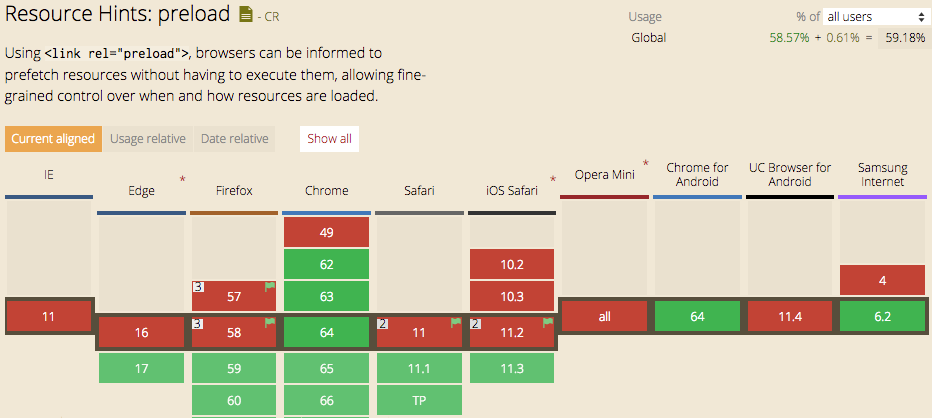
еңЁдёҚж”ҜжҢҒ preload зҡ„жөҸи§ҲеҷЁзҺҜеўғдёӯпјҢдјҡеҝҪз•ҘеҜ№еә”зҡ„ link ж ҮзӯҫпјҢиҖҢиӢҘйңҖиҰҒеҒҡзү№еҫҒжЈҖжөӢзҡ„иҜқпјҢеҲҷпјҡ
const isPreloadSupported = () => {
const link = document.createElement('link');
const relList = link.relList;
if (!relList || !relList.supports) {
return false;
}
return relList.supports('preload');
};
preload жҳҜе‘ҠиҜүжөҸи§ҲеҷЁйЎөйқўеҝ…е®ҡйңҖиҰҒзҡ„иө„жәҗпјҢжөҸи§ҲеҷЁдёҖе®ҡдјҡеҠ иҪҪиҝҷдәӣиө„жәҗпјӣ
prefetch жҳҜе‘ҠиҜүжөҸи§ҲеҷЁйЎөйқўеҸҜиғҪйңҖиҰҒзҡ„иө„жәҗпјҢжөҸи§ҲеҷЁдёҚдёҖе®ҡдјҡеҠ иҪҪиҝҷдәӣиө„жәҗгҖӮ
preload жҳҜзЎ®и®ӨдјҡеҠ иҪҪжҢҮе®ҡиө„жәҗпјҢеҰӮеңЁжҲ‘们зҡ„еңәжҷҜдёӯпјҢx-report.js еҲқе§ӢеҢ–еҗҺдёҖе®ҡдјҡеҠ иҪҪ PcCommon.js е’Ң TabsPc.js, еҲҷеҸҜд»Ҙйў„е…Ҳ preload иҝҷдәӣиө„жәҗпјӣ
prefetch жҳҜйў„жөӢдјҡеҠ иҪҪжҢҮе®ҡиө„жәҗпјҢеҰӮеңЁжҲ‘们зҡ„еңәжҷҜдёӯпјҢжҲ‘们еңЁйЎөйқўеҠ иҪҪеҗҺдјҡеҲқе§ӢеҢ–йҰ–еұҸ组件пјҢеҪ“з”ЁжҲ·ж»ҡеҠЁйЎөйқўж—¶пјҢдјҡжӢүеҸ–第дәҢеұҸзҡ„组件пјҢиӢҘиғҪйў„жөӢз”ЁжҲ·иЎҢдёәпјҢеҲҷеҸҜд»Ҙ prefetch дёӢдёҖеұҸзҡ„组件гҖӮ
дҪҝз”Ё preload еүҚпјҢеңЁйҒҮеҲ°иө„жәҗдҫқиө–ж—¶иҝӣиЎҢеҠ иҪҪпјҡ

дҪҝз”Ё preload еҗҺпјҢдёҚз®Ўиө„жәҗжҳҜеҗҰдҪҝз”ЁйғҪе°ҶжҸҗеүҚеҠ иҪҪпјҡ

еҸҜд»ҘзңӢеҲ°пјҢpreload зҡ„иө„жәҗеҠ иҪҪйЎәеәҸе°Ҷиў«жҸҗеүҚпјҡ
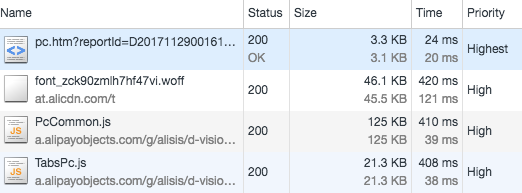
дҪҝз”Ё preload еҗҺпјҢChrome дјҡжңүдёҖдёӘиӯҰе‘Ҡпјҡ

еҰӮдёҠж–ҮжүҖиЁҖпјҢиӢҘдёҚзЎ®е®ҡиө„жәҗжҳҜеҝ…е®ҡдјҡеҠ иҪҪзҡ„пјҢеҲҷдёҚиҰҒй”ҷиҜҜдҪҝз”Ё preloadпјҢд»Ҙе…Қжң¬жң«еҖ’зҪ®пјҢз»ҷйЎөйқўеёҰжқҘжӣҙжІүйҮҚзҡ„иҙҹжӢ…гҖӮ
еҪ“然пјҢеҸҜд»ҘеңЁ PC дёӯдҪҝз”Ё preload жқҘеҲ·ж–°иө„жәҗзҡ„зј“еӯҳпјҢдҪҶеңЁз§»еҠЁз«ҜеҲҷйңҖиҰҒзү№еҲ«ж…ҺйҮҚпјҢеӣ дёәеҸҜиғҪдјҡжөӘиҙ№з”ЁжҲ·зҡ„еёҰе®ҪгҖӮ
preload е’Ң prefetch ж··з”Ёзҡ„иҜқпјҢ并дёҚдјҡеӨҚз”Ёиө„жәҗпјҢиҖҢжҳҜдјҡйҮҚеӨҚеҠ иҪҪгҖӮ
<link rel="preload" href="https://at.alicdn.com/t/font_zck90zmlh7hf47vi.woff" rel="external nofollow" rel="external nofollow" rel="external nofollow" rel="external nofollow" rel="external nofollow" rel="external nofollow" as="font"> <link rel="prefetch" href="https://at.alicdn.com/t/font_zck90zmlh7hf47vi.woff" rel="external nofollow" rel="external nofollow" rel="external nofollow" rel="external nofollow" rel="external nofollow" rel="external nofollow" as="font">
дҪҝз”Ё preload е’Ң prefetch зҡ„йҖ»иҫ‘еҸҜиғҪдёҚжҳҜеҶҷеҲ°дёҖиө·пјҢдҪҶдёҖж—ҰеҸ‘з”ҹеҜ№з”ЁдёҖиө„жәҗ preload жҲ– prefetch зҡ„иҜқпјҢдјҡеёҰжқҘеҸҢеҖҚзҡ„зҪ‘з»ңиҜ·жұӮпјҢиҝҷзӮ№йҖҡиҝҮ Chrome жҺ§еҲ¶еҸ°зҡ„зҪ‘з»ңйқўжқҝе°ұиғҪз”„еҲ«пјҡ

иӢҘ css дёӯжңүеә”з”ЁдәҺе·ІжёІжҹ“еҲ° DOM ж ‘зҡ„е…ғзҙ зҡ„йҖүжӢ©еҷЁпјҢдё”и®ҫзҪ®дәҶ @font-face 规еҲҷж—¶пјҢдјҡи§ҰеҸ‘еӯ—дҪ“ж–Ү件зҡ„еҠ иҪҪгҖӮ иҖҢеӯ—дҪ“ж–Ү件еҠ иҪҪдёӯж—¶пјҢDOM дёӯзҡ„иҝҷдәӣе…ғзҙ пјҢжҳҜеӨ„дәҺдёҚеҸҜи§Ғзҡ„зҠ¶жҖҒгҖӮеҜ№е·ІзҹҘеҝ…еҠ иҪҪзҡ„ font ж–Ү件иҝӣиЎҢйў„еҠ иҪҪпјҢйҷӨдәҶжңүжҖ§иғҪжҸҗеҚҮеӨ–пјҢжӣҙжңүдҪ“йӘҢдјҳеҢ–зҡ„ж•ҲжһңгҖӮ
еңЁжҲ‘们зҡ„еңәжҷҜдёӯпјҢе·ІзҹҘ antd.css дјҡдҫқиө– font ж–Ү件пјҢжүҖд»ҘжҲ‘们еҸҜд»ҘеҜ№иҝҷдёӘеӯ—дҪ“ж–Ү件иҝӣиЎҢ preload:
<link rel="preload" as="font" href="https://at.alicdn.com/t/font_zck90zmlh7hf47vi.woff" rel="external nofollow" rel="external nofollow" rel="external nofollow" rel="external nofollow" rel="external nofollow" rel="external nofollow" >
然иҖҢжҲ‘еҸ‘зҺ°иҝҷдёӘж–Ү件еҠ иҪҪдәҶдёӨж¬Ўпјҡ



еҺҹеӣ жҳҜеҜ№и·Ёеҹҹзҡ„ж–Ү件иҝӣиЎҢ preload зҡ„ж—¶еҖҷпјҢжҲ‘们еҝ…йЎ»еҠ дёҠ crossorigin еұһжҖ§пјҡ
<link rel="preload" as="font" crossorigin href="https://at.alicdn.com/t/font_zck90zmlh7hf47vi.woff" rel="external nofollow" rel="external nofollow" rel="external nofollow" rel="external nofollow" rel="external nofollow" rel="external nofollow" >
еҶҚзңӢдёҖдёӢзҪ‘з»ңиҜ·жұӮпјҢе°ұеҸҳжҲҗдёҖжқЎдәҶгҖӮ
W3 规иҢғжҳҜиҝҷд№Ҳи§ЈйҮҠзҡ„пјҡ
Preload links for CORS enabled resources, such as fonts or images with a crossorigin attribute, must also include a crossorigin attribute, in order for the resource to be properly used.
йӮЈдёәдҪ•дјҡжңүдёӨжқЎиҜ·жұӮпјҢдё”дјҳе…Ҳзә§дёҚдёҖиҮҙпјҢеҸҲжІЎжңүе‘Ҫдёӯзј“еӯҳе‘ўпјҹиҝҷе°ұеҫ—еј•еҮәдёӢдёҖдёӘиҜқйўҳжқҘи§ЈйҮҠдәҶгҖӮ
жҲ‘们е…ҲжқҘзңӢдёҖеј еӣҫпјҡ
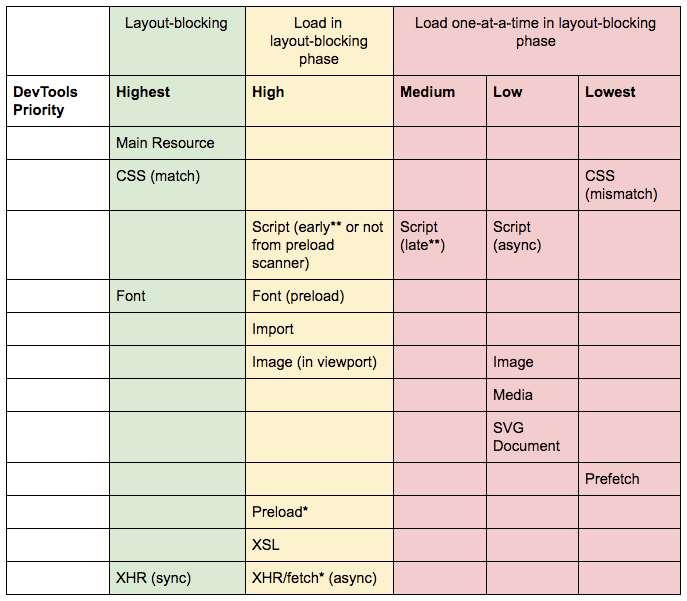
иҝҷеј иЎЁиҜҰи§ҒпјҡChrome Resource Priorities and Scheduling
иҝҷеј еӣҫиЎЁзӨәзҡ„жҳҜпјҢеңЁ Chrome 46 д»ҘеҗҺзҡ„зүҲжң¬дёӯпјҢдёҚеҗҢзҡ„иө„жәҗеңЁжөҸи§ҲеҷЁжёІжҹ“зҡ„дёҚеҗҢйҳ¶ж®өиҝӣиЎҢеҠ иҪҪзҡ„дјҳе…Ҳзә§гҖӮ еңЁиҝҷйҮҢпјҢжҲ‘们еҸӘйңҖиҰҒе…іжіЁ DevTools Priority дҪ“зҺ°зҡ„дјҳе…Ҳзә§пјҢдёҖе…ұеҲҶжҲҗдә”дёӘзә§еҲ«пјҡ
Highest жңҖй«ҳ
Hight й«ҳ
Medium дёӯзӯү
Low дҪҺ
Lowest жңҖдҪҺ




CSS(match) жҢҮзҡ„жҳҜеҜ№е·Іжңүзҡ„ DOM е…·еӨҮ规еҲҷзҡ„жңүж•Ҳзҡ„ж ·ејҸж–Ү件гҖӮ


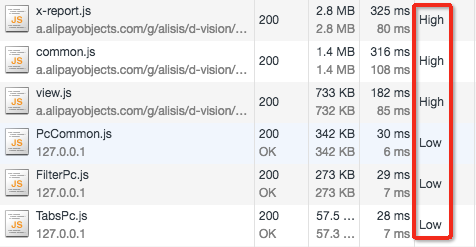
еүҚдёүдёӘ js ж–Ү件жҳҜеҶҷжӯ»еңЁ html дёӯзҡ„йқҷжҖҒиө„жәҗдҫқиө–пјҢеҗҺдёүдёӘ js ж–Ү件жҳҜж №жҚ®йҰ–еұҸжҢүйңҖејӮжӯҘеҠ иҪҪзҡ„组件иө„жәҗдҫқиө–пјҢиҝҷжӯЈйӘҢиҜҒдәҶиҝҷдёӘ规еҲҷгҖӮ


ж ·ејҸж–Ү件дёӯжңүдёҖдёӘ @font-face дҫқиө–дёҖдёӘ font ж–Ү件пјҢж ·ејҸж–Ү件дёӯдҫқиө–зҡ„еӯ—дҪ“ж–Ү件еҠ иҪҪзҡ„дјҳе…Ҳзә§жҳҜ Highestпјӣ еңЁдҪҝз”Ё preload йў„еҠ иҪҪиҝҷдёӘ font ж–Ү件时пјҢиӢҘдёҚжҢҮе®ҡ crossorigin еұһжҖ§(еҚідҪҝеҗҢжәҗ)пјҢеҲҷдјҡйҮҮз”ЁеҢҝеҗҚжЁЎејҸзҡ„ CORS еҺ»еҠ иҪҪпјҢдјҳе…Ҳзә§жҳҜ HighпјҢзңӢдёӢеӣҫеҜ№жҜ”пјҡ 第дёҖжқЎ High дјҳе…Ҳзә§д№ҹе°ұжҳҜ preload зҡ„иҜ·жұӮпјҡ
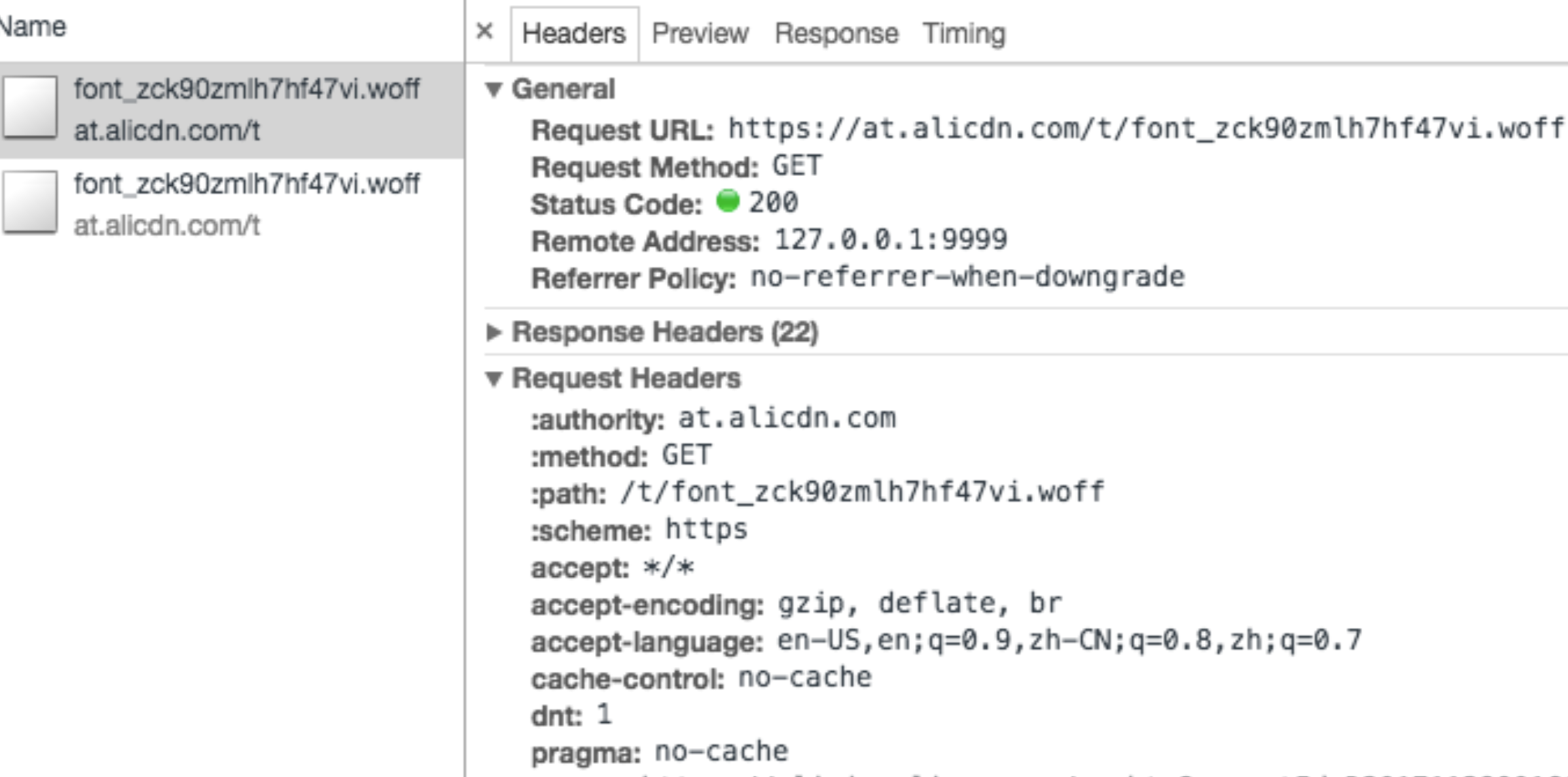
第дәҢжқЎ Highest д№ҹе°ұжҳҜж ·ејҸеј•е…Ҙзҡ„иҜ·жұӮпјҡ
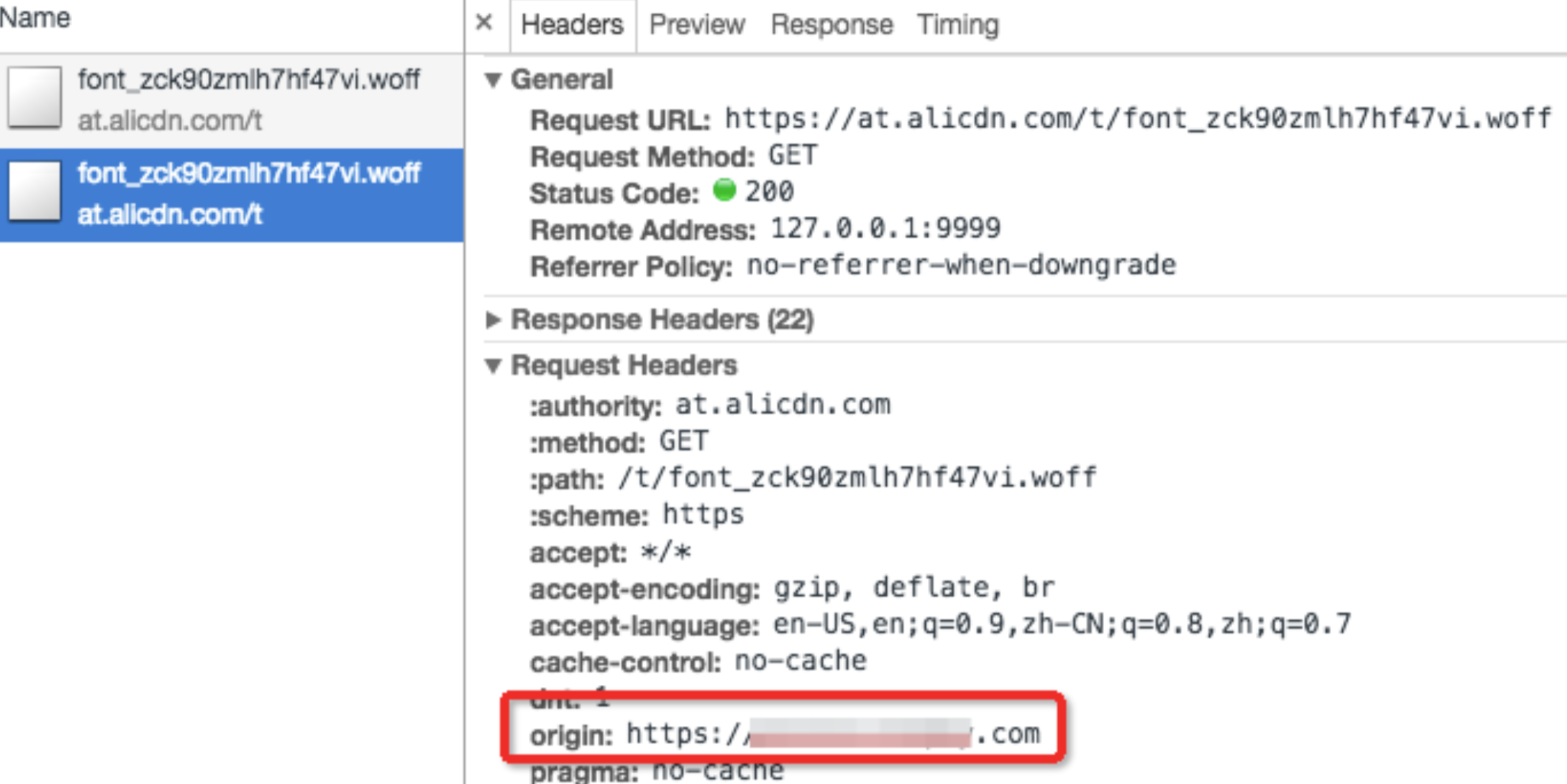
еҸҜд»ҘзңӢеҲ°пјҢеңЁ preload зҡ„иҜ·жұӮдёӯпјҢзјәе°‘дәҶдёҖдёӘ origin зҡ„иҜ·жұӮеӨҙеӯ—ж®өпјҢиЎЁзӨәиҝҷдёӘиҜ·жұӮжҳҜеҢҝеҗҚзҡ„иҜ·жұӮгҖӮ и®©иҝҷдёӨдёӘиҜ·жұӮиғҪе…ұз”Ёзј“еӯҳзҡ„иҜқпјҢзӣ®еүҚзҡ„и§Јжі•жҳҜз»ҷ preload еҠ дёҠ crossorigin еұһжҖ§пјҢиҝҷж ·иҜ·жұӮеӨҙдјҡеёҰдёҠ origin, дё”дёҺж ·ејҸеј•е…Ҙзҡ„иҜ·жұӮеҗҢжәҗпјҢд»ҺиҖҢеҒҡеҲ°е‘Ҫдёӯзј“еӯҳпјҡ
<link rel="preload" as="font" crossorigin href="https://at.alicdn.com/t/font_zck90zmlh7hf47vi.woff" rel="external nofollow" rel="external nofollow" rel="external nofollow" rel="external nofollow" rel="external nofollow" rel="external nofollow" >
иҝҷд№ҲиҜ·жұӮе°ұеҸӘеү©дёҖдёӘпјҡ

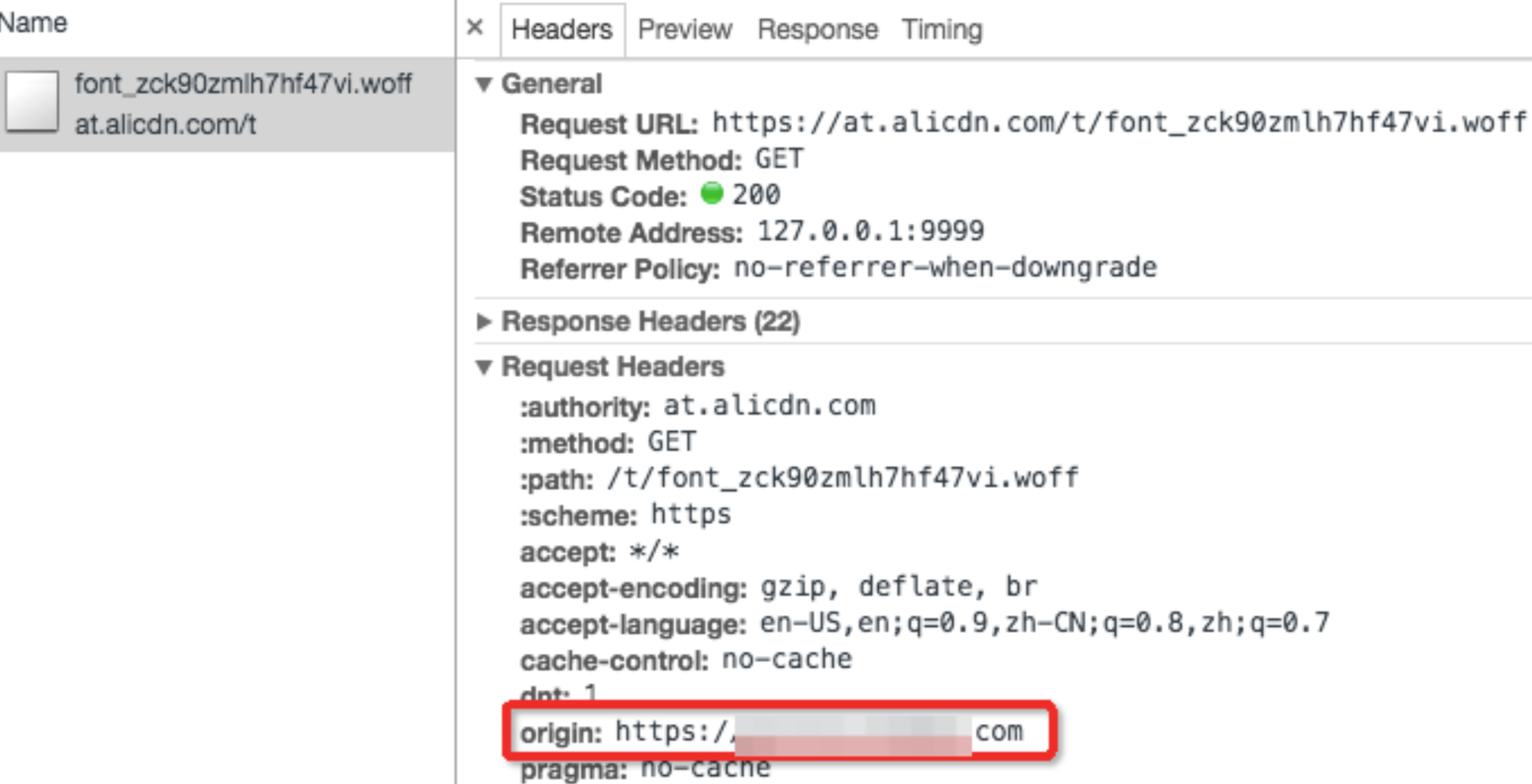
еңЁзҪ‘з»ңзҖ‘еёғжөҒеӣҫдёӯпјҢд№ҹжҳҫзӨәжҲҗеҠҹйў„еҠ иҪҪдё”еҗҺз»ӯе‘Ҫдёӯзј“еӯҳдёҚеҶҚдәҢж¬ЎеҠ иҪҪпјҡ

preload жҳҜдёӘеҘҪдёңиҘҝпјҢиғҪе‘ҠиҜүжөҸи§ҲеҷЁжҸҗеүҚеҠ иҪҪеҪ“еүҚйЎөйқўеҝ…йЎ»зҡ„иө„жәҗпјҢе°ҶеҠ иҪҪдёҺи§Јжһҗжү§иЎҢеҲҶзҰ»ејҖпјҢеҒҡеҫ—еҘҪеҸҜд»ҘеҜ№йҰ–ж¬ЎжёІжҹ“еёҰжқҘдёҚе°Ҹзҡ„жҸҗеҚҮпјҢдҪҶиҰҒйҒҝе…Қж»Ҙз”ЁпјҢеҢәеҲҶе…¶дёҺ prefetch зҡ„е…ізі»пјҢдё”йңҖиҰҒзҹҘйҒ“ preload дёҚеҗҢиө„жәҗж—¶зҡ„зҪ‘з»ңдјҳе…Ҳзә§е·®ејӮгҖӮ
preload еҠ иҪҪйЎөйқўеҝ…йңҖзҡ„иө„жәҗеҰӮ CDN дёҠзҡ„еӯ—дҪ“ж–Ү件пјҢдёҺ prefetch йў„жөӢеҠ иҪҪдёӢдёҖеұҸж•°жҚ®пјҢе…ҙи®ёжҳҜдёӘдёҚй”ҷзҡ„з»„еҗҲгҖӮ
жӣҙеӨҡе…ідәҺpreloadйў„еҠ иҪҪйЎөйқўзҡ„ж–Үз« еӨ§е®¶еҸҜд»ҘзңӢзңӢдёӢйқўзҡ„зӣёе…ій“ҫжҺҘ
е…ҚиҙЈеЈ°жҳҺпјҡжң¬з«ҷеҸ‘еёғзҡ„еҶ…е®№пјҲеӣҫзүҮгҖҒи§Ҷйў‘е’Ңж–Үеӯ—пјүд»ҘеҺҹеҲӣгҖҒиҪ¬иҪҪе’ҢеҲҶдә«дёәдё»пјҢж–Үз« и§ӮзӮ№дёҚд»ЈиЎЁжң¬зҪ‘з«ҷз«ӢеңәпјҢеҰӮжһңж¶үеҸҠдҫөжқғиҜ·иҒ”зі»з«ҷй•ҝйӮ®з®ұпјҡis@yisu.comиҝӣиЎҢдёҫжҠҘпјҢ并жҸҗдҫӣзӣёе…іиҜҒжҚ®пјҢдёҖз»ҸжҹҘе®һпјҢе°Ҷз«ӢеҲ»еҲ йҷӨж¶үе«ҢдҫөжқғеҶ…е®№гҖӮ
жӮЁеҘҪпјҢзҷ»еҪ•еҗҺжүҚиғҪдёӢи®ўеҚ•е“ҰпјҒ